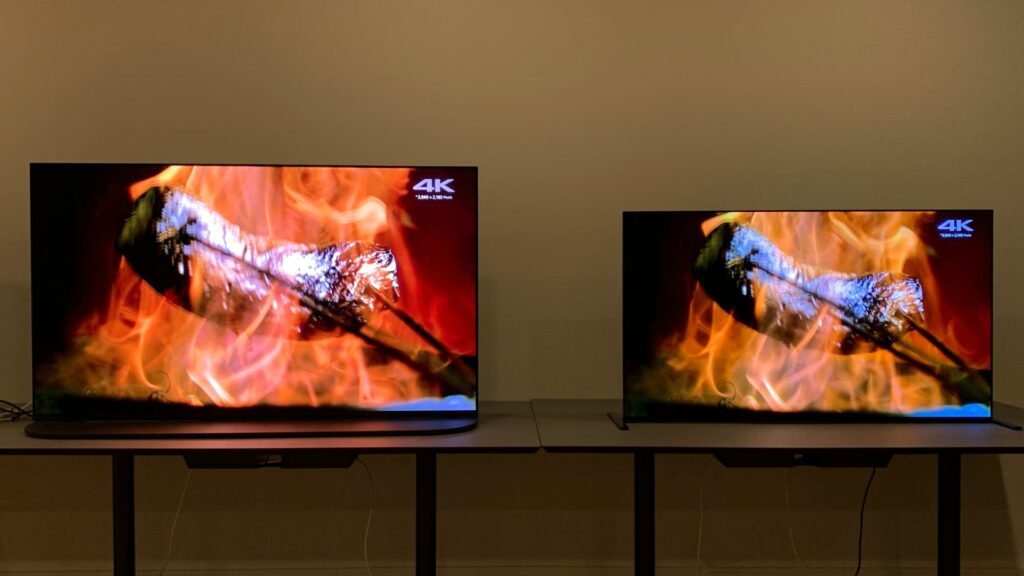When it comes to high-quality TVs, Sony is a brand that consistently delivers cutting-edge technology and performance. Sony’s OLED and LED TV models are two of the most popular choices for consumers, offering impressive visuals and features. However, these two types of TVs differ significantly in terms of display technology, image quality, and price. In this article, we’ll break down the key differences between Sony’s OLED and LED TVs to help you make an informed decision.

Understanding OLED vs. LED Technology
- OLED (Organic Light Emitting Diode): OLED TVs use self-emitting pixels that generate their own light, meaning each pixel can turn on or off individually. This results in perfect blacks and excellent contrast ratios. OLED screens are thinner and can produce deeper, richer colors than LED TVs.
- LED (Light Emitting Diode): LED TVs are essentially LCD TVs that use LED backlighting to illuminate the screen. While LED technology has advanced over the years, it still relies on a backlight, which limits its ability to produce true black levels. The brightness and color accuracy are still good but not as impressive as OLED.
Picture Quality Comparison
- OLED: One of the most significant advantages of OLED technology is its ability to produce true black levels. Since OLED pixels can turn off completely, the blacks appear completely dark, which leads to a higher contrast ratio. This results in vibrant colors, better detail in dark scenes, and more immersive viewing experiences.
- LED: While Sony’s LED TVs offer excellent picture quality, especially with the use of advanced technologies like Full Array Local Dimming and X-Tended Dynamic Range, they still rely on a backlight. As a result, black levels can appear more like dark gray, especially in scenes with little light. The contrast is good, but not on par with OLED’s deep blacks.
Brightness and Color Performance
- OLED: OLED TVs are known for their exceptional color accuracy and deep saturation. The self-emissive nature of the display allows for rich, vibrant colors, and it excels in dark-room settings. However, OLED TVs might not achieve the same peak brightness as LED TVs, which can affect their performance in very bright rooms.
- LED: LED TVs, on the other hand, tend to have higher peak brightness levels, making them better suited for well-lit environments. They also tend to have a wider range of colors and better color accuracy, especially with Sony’s Triluminos technology, which improves the color gamut and sharpness.
Viewing Angles
- OLED: OLED TVs offer superior viewing angles compared to LED models. Since OLED pixels emit their own light, there is no loss of brightness or color shift when you view the TV from an angle. This makes OLED TVs ideal for watching content with multiple people from different spots in the room.
- LED: LED TVs tend to lose color accuracy and brightness when viewed from an angle. The picture may appear washed out, especially on cheaper LED models. However, higher-end Sony LED TVs with better viewing angle technology can mitigate this issue to some extent.
Design and Build Quality
- OLED: Sony’s OLED TVs are thinner and sleeker than their LED counterparts due to the absence of a backlight. OLED panels can be as thin as a few millimeters, making them a perfect choice for wall mounting or sleek entertainment setups. The overall design is more modern and minimalistic.
- LED: Sony’s LED TVs are generally thicker than OLED models due to the backlighting system. While still offering great build quality, they are not as sleek as OLED models. However, LED TVs come in a wider range of sizes, especially in the budget and mid-range categories.
Lifespan and Burn-In Concerns
- OLED: One potential drawback of OLED technology is the risk of burn-in. If static images (like logos or news tickers) are left on the screen for extended periods, they can cause permanent damage to the pixels. However, with proper usage and settings adjustments, this issue can be minimized.
- LED: LED TVs do not have burn-in issues and tend to have a longer lifespan than OLED panels. The backlight can degrade over time, but the overall lifespan of an LED TV is typically longer than an OLED TV.
Conclusion
Both Sony’s OLED and LED TVs offer exceptional picture quality, but they cater to different needs and preferences. OLED TVs provide superior contrast, color accuracy, and viewing angles, making them the go-to choice for those seeking the best possible picture quality. On the other hand, Sony’s LED TVs are more affordable and better suited for well-lit environments, offering excellent performance without the higher price tag. Ultimately, the choice between OLED and LED depends on your budget, viewing habits, and the kind of viewing experience you want to create in your home.




